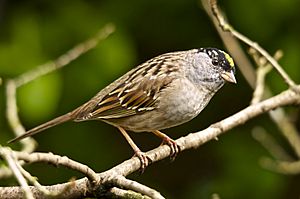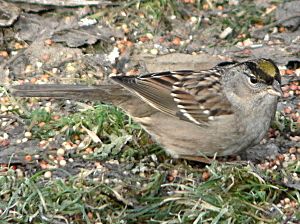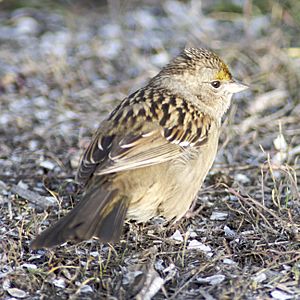Golden-crowned sparrow facts for kids
Quick facts for kids Golden-crowned sparrow |
|
|---|---|
 |
|
| Adult; males and females are similarly plumaged | |
| Conservation status | |
| Scientific classification | |
| Genus: |
Zonotrichia
|
| Species: |
atricapilla
|
 |
|
| Synonyms | |
|
Emberiza atricapilla Gmelin, 1789 |
|
The golden-crowned sparrow (Zonotrichia atricapilla) is a large New World sparrow that lives in western North America. It's known for the bright yellow patch on its head.
Contents
About the Golden-Crowned Sparrow's Family
The golden-crowned sparrow is one of five types of sparrows in the Zonotrichia group. These are all large American sparrows. This bird does not have any different types or subspecies.
It is very closely related to the white-crowned sparrow. Scientists have studied their mitochondrial DNA. This shows that these two birds became separate species only recently in Earth's history. The white-throated sparrow is also a relative, but a bit more distant. Sometimes, golden-crowned sparrows have even bred with white-crowned and white-throated sparrows.
An expert on birds, John Latham, first wrote about this bird in 1781. However, he didn't give it a scientific name. This was fixed in 1789 by Johann Friedrich Gmelin. He named it Emberiza atricapilla. Later, other scientists like John James Audubon placed it in different bird groups. But many eventually put it in its current group, Zonotrichia. Another scientist, Peter Simon Pallas, described the same bird in 1844. He called it Zonotrichia coronata. This name was used for much of the 1800s.
The scientific name Zonotrichia comes from Greek words. Zone means "band" and thrix means "hair". The second part, atricapilla, is Latin. Ater means "black" and capillus means "hair of the head". So, the name describes a bird with a "band of hair" and "black hair on its head."
What Does It Look Like?
The adult golden-crowned sparrow is a fairly large American sparrow. It is about 15 to 18 centimeters (6 to 7 inches) long. Its wingspan is about 24.75 centimeters (9.75 inches). It weighs from 19 to 35.4 grams (0.67 to 1.25 ounces).
Like other Zonotrichia sparrows, it has a long, square-tipped tail. It also has a slightly peaked crown on its head. Male and female birds look very similar. Males are usually a little bigger than females.
The upper part of the adult bird is grayish-brown. It has brownish-black streaks on its back. Its belly is gray and a bit lighter. Its wings and tail are brown. It also has two white bars on its wings. Its legs are pale brown. Its bill is dark, with the top part darker than the bottom. Its eyes are brown.
During the breeding season, the golden-crowned sparrow has a bright yellow stripe on the top of its head. This stripe becomes pale gray towards the back of its head.
Similar Birds
Adult golden-crowned sparrows are easy to spot because of their unique head colors. But young birds or those not in breeding season can look similar to other sparrows. They might be confused with white-crowned or white-throated sparrows.
You can tell it apart from the white-crowned sparrow by its head pattern. Also, its bill is dusky (darkish), not pale pink or yellowish. It's different from the white-throated sparrow because it's larger. It also has a plain throat and no buff-colored stripe on its head. A young bird might also look like a female house sparrow. But the golden-crowned sparrow is larger, darker, and has a longer tail. It usually has some dull yellow feathers on its forehead too.
Where Does It Live?
The golden-crowned sparrow is common along the western side of North America. It is a bird that migrates, meaning it travels long distances. It breeds in north-central Alaska and central Yukon. It also breeds south to the northwestern part of Washington state.
In winter, it flies south. It spends winter from southern coastal Alaska down to northern Baja California. Sometimes, it has been seen far away in Japan and Russia. It can also sometimes fly as far as the eastern coast of North America. This includes places from Nova Scotia to Florida.
In winter, you can usually find it in areas with lots of bushes. It especially likes dense shrubs.
How It Behaves
In winter, golden-crowned sparrows live in flocks. They stay with other golden-crowned sparrows. They also often join flocks with other sparrow species, especially white-crowned sparrows. These flocks usually live in areas about 15 to 20 acres in size. Individual birds stay with the same flock all winter. They also return to the same wintering spot every year.
Studies show that the black and gold stripes on a golden-crowned sparrow's head are important. They act like signals to show a bird's social status within its flock. These signals help to reduce fights between birds. This saves them from injuries or wasting energy. The size and color of a bird's head patches can tell you more about its dominance (who will back down in a confrontation) than its size or sex. Birds with similar gold patches are more likely to fight. The outcome of these fights can be predicted by the color of their black stripes. This means their social status is complex. The different colored patches allow for many types of interactions between birds in the flock.
What Does It Eat?
Like other Zonotrichia sparrows, the golden-crowned sparrow finds its food on the ground. It looks for food by pecking and scratching. Sometimes, it will jump into the air to catch insects. It also picks insects off leaves, which is called gleaning.
Its diet is mostly plants, especially in winter. It eats seeds, berries, flowers, and buds. It also eats crawling insects sometimes. This bird is very helpful for getting rid of weed seeds. It eats seeds from various plants like ryegrass, fescue, bromes, pigweeds, chickweed, mulleins, filaree, common knotweed, and even poison oak. When birds are paired up, they often look for food together. The male usually follows the female.
The species gains weight twice a year. Once in mid-winter, and then a lot more just before it flies north in the spring. This higher weight stays until the bird reaches its breeding grounds.
Reproduction and Life Cycle
The breeding season for golden-crowned sparrows is from late May to early August. Males sing all day from a high spot in their breeding area. The female builds the nest. It is a large cup-shaped nest. She makes it from dried plant material and lines it with hair, fine grasses, and feathers. The nest is usually on the ground, but sometimes on a low branch.
The female typically lays five eggs. However, sometimes she lays three to five eggs. The eggs are pale green, oval, and have many reddish-brown spots. They are about 0.65 to 0.67 millimeters by 0.80 to 0.82 millimeters in size. The female sits on the eggs for 11 to 14 days to keep them warm. This is called incubation.
The young birds are altricial. This means they are born naked, blind, and helpless. But they leave the nest within 12 days. Both parents help feed the young birds.
The oldest known golden-crowned sparrow lived for at least 10 years and 6 months. It was marked with a band as an adult one winter. Then, it was caught again nine winters later.
What Does It Sound Like?
The golden-crowned sparrow's song is a three-note whistle. The sound goes down in pitch. It is very easy to recognize. People often describe it as oh-dear-me. The call also sounds like the words I'm so weary. Because of this, Alaskan gold miners used to call this bird "Weary Willie."
However, birds in the mountains of British Columbia have a trill (a rapid up-and-down sound) on the third note. This is different from the clear whistle of other populations. These songs are mostly heard during the breeding season. But you can also hear them in their wintering areas just after they arrive in the fall. You can also hear them just before they leave for spring migration. Like other Zonotrichia sparrows, it has a sharp, clear call note. This call sounds like tsew.
Is It Safe? (Conservation)
The International Union for the Conservation of Nature says the golden-crowned sparrow is a species of least concern. This means it is not in danger. The sparrow lives in a very large area. Its population is also very big. These factors mean it is far from being an endangered species. Data from Christmas Bird Counts show that its numbers are steady or even growing.
Across its range, it is protected by the Migratory Bird Treaty Act of 1918. Many of its winter homes are in protected areas. These include national forests and national wildlife refuges.
Like other passerine birds that live in flocks, the golden-crowned sparrow can have many feather mites. It can also host other small creatures. These include chiggers, chewing lice (like Machaerilaemus maestum), and hippoboscid flies (like Ornithoica vicina). Diseases like canarypox are also known to affect it.
Many different predators hunt the golden-crowned sparrow at different times in its life. These include northern and loggerhead shrikes, sharp-shinned and Cooper's hawks, northern harriers, merlins, mountain pygmy owls, western screech owls, barn owls, feral cats, and Columbian ground squirrels.
Images for kids
See also
 In Spanish: Gorrión gorridorado para niños
In Spanish: Gorrión gorridorado para niños








